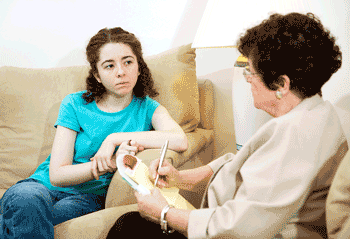 If your child has been diagnosed with a mental health disorder, you may be told that your child may benefit from receiving evidence-based treatment. Evidence-based treatments are those that research has showed to be effective.
If your child has been diagnosed with a mental health disorder, you may be told that your child may benefit from receiving evidence-based treatment. Evidence-based treatments are those that research has showed to be effective.
There are a lot of different kinds of behavioral therapy because each is customized to work effectively with a specific disorder or set of disorders. They have been tested on children with that specific disorder, and they have been manualized — that is, spelled out step-by-step to ensure that the techniques are use in the manner and sequence that have been shown to be most effective. There are also clear measures of a child’s progress, and an estimated duration for the treatment.
Here’s a look at some of the most common behavioral treatments that are effective for children and youth.
Who is it for? Applied Behavior Analysis (ABA) is for children with autism spectrum disorders.
What is it? ABA is an intensive intervention designed to help children with autism develop behaviors they don’t pick up the way neurotypical children do, including social, verbal, and motor skills, and decrease behaviors that are problematic or self-injurious.
How does it work? ABA uses close observation of your child’s behavior and positive prompts or reinforcement to increase desired behaviors. Problematic behaviors are addressed by studying what occurs before and after the behavior and altering those triggers or reinforcements rather than focusing on the behavior itself.
Who is it for? Cognitive behavioral therapy (CBT) is used to treat a wide range of disorders and difficulties.
What is it? CBT is based on the premise that thoughts (cognitions), feelings, and behaviors all influence one another. CBT is an umbrella term for many specific kinds of therapy tailored to specific psychiatric disorders.
How does it work? A therapist can use CBT to help your child identify how her thoughts influence her behaviors, or change her behaviors, which in turn can help her change the way she manages unwanted feelings and thoughts.
Who is it for? Dialectical behavior therapy (DBT) is used to treat a wide range of psychiatric issues. DBT was originally developed for people with borderline personality disorder, but has been used successfully to treat eating disorders, suicidal and self-injurious behavior, depression, and substance abuse.
What is it? Dialectical behavior therapy, (DBT) focuses on accepting rather than challenging difficult thoughts, while at the same time initiating change.
How does it work? DBT helps individuals focus on accepting, rather than becoming overwhelmed by, difficult thoughts by using what’s called “mindful awareness” while taking steps to improve interpersonal interactions and avoid problematic behavior. It’s called dialectical because it involves balancing both acceptance and change.
Who is it for? Interpersonal psychotherapy is often used to treat children and adolescents with depression, but can be helpful with a wide-range of psychological issues and disorders.
What is it? Interpersonal psychotherapy is a form of short-term therapy that focuses on helping your child explore how her relationships with peers and family positively (and negatively) affect her mood and behavior.
How does it work? Interpersonal therapy helps your child identify things that might be adversely affecting her mood—including conflicts, transitions, grief, and negative patterns in relationships—and make improvements that can positively impact her feelings and behavior.
Who is it for? Motivational interviewing is often used with adolescent substance abusers who have been directed to treatment by parents or authorities and are unlikely to succeed in it unless they perceive a benefit for themselves.
What is it? Motivational interviewing is focuses on exploring and resolving ambivalence to treatment in order to increase motivation to change problematic behavior.
How does it work? In a motivational interview, the therapist is collaborative rather than confrontational. The emphasis is on understanding the child’s point of view, eliciting the child’s ideas about change, and emphasizing the child’s responsibility for his behavior.
Who is it for? Parent-child interaction therapy is for parents and children who are struggling to interact in a positive, productive way.
What is it? Parent-child interaction therapy is a therapeutic technique that restructures the interaction between you and your child to reduce conflict, improve the attachment relationship, and reduce disruptive behaviors.
How does it work? A therapist will help teach you to give effective positive reinforcement for desired behaviors and consistent consequences for undesirable behaviors. Once you’ve learned these new skills, you’ll receive live coaching (via a bug in the ear) from a therapist who watches from behind a one-way mirror as you and your child interact. The goal of parent-child interaction therapy is to help children, youth and parents enjoy a more positive relationship by teaching parents to exercise their authority calmly and consistently, and helping children learn to manage their own behavior more effectively.
Who is it for? Trauma-focused cognitive behavior therapy is for children and adolescents who have experienced trauma.
What is it? A kind of cognitive behavioral therapy specifically geared to helping children and parents learn to process a disturbing experience in a healthy way.
How does it work? A trauma-focused cognitive therapist will teach your child skills that will help him manage distressing thoughts and feelings, rather than avoiding them, and allow him to recover his sense of well-being.

